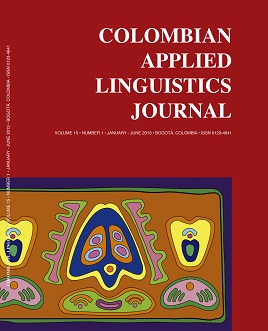DOI:
https://doi.org/10.14483/udistrital.jour.calj.2013.1.a07Published:
2013-01-01Issue:
Vol 15, No 1 (2013) January-JuneSection:
Research ArticlesEstablishing placement test fit and performance: serving local needs
Establecimiento de ajuste y desempeño en exámenes de clasificación de acuerdo con necesidades locales
Keywords:
Programas de lenguas, análisis de exámenes (es).Keywords:
Language programs, tests analysis. (en).Abstract (en)
Accountability in language education is often associated with top-down national policies unresponsive—or even hostile to—local needs; however, when accountability is driven by local stakeholders seeking to better understand and enhance their programs, it can foster productive cycles of action research and curriculum development. This paper reports on one such internally-motivated accountability effort, in which program insiders sought to determine the efficacy of a reading test being administered to a new population of students at one Colombian university. Descriptive statistics, reliability estimates, and item facility and discrimination measures were used to determine whether this test was sufficiently reliable and appropriately matched to test takers’ ability in order to warrant its use as part of a high-stakes English-language placement exam. A detailed analysis of this test is used not only to propose specific recommendations for revision but also to illustrate a useful set of statistical tools appropriate for test analysis in other language programs. Moreover, we conclude that the involvement of local instructors as part of an iterative, self-reflective, test development process provides opportunities for professional development and deeper engagement in accountability projects.
Abstract (es)
Frecuentemente se asocia el concepto de accountability en la enseñanza de lenguas con políticas de estado impositivas que pueden ser indiferentes ante (o ser hostiles a) las necesidades de la comunidad académica local. Sin embargo, cuando los proyectos de accountability son impulsados por la misma comunidad académica—buscando dentro sus programas curriculares un mejor conocimiento de si mismos—estos proyectos pueden fomentar ciclos productivos de investigación-acción y de desarrollo curricular. Este ensayo presenta parte de los resultados de una investigación en accountability motivada internamente dentro de un programa de lenguas en una universidad colombiana; como parte de ésta, los involucrados locales querían determinar en qué medida la prueba de lectura establecida por la universidad era apropiada para una nueva población de estudiantes. Se calcularon las estadísticas descriptivas, estimaciones de confiabilidad y medidas de item facility y item discrimination para determinar si el examen fue lo suficientemente confiable y si se adecuaba bien a las habilidades de los estudiantes para justificar el uso de este examen como parte de una prueba de clasificación de alto impacto. Se usó un análisis detallado de este examen para sugerir revisiones específicas y para ilustrar el uso de un grupo de herramientas estadísticas para el análisis de exámenes que pueden ser usadas dentro de otros programas de lenguas. Concluimos que la participación de los profesores locales dentro de un proceso de desarrollo cíclico y auto-reflexivo les da oportunidades para su desarrollo profesional y un nivel de compromiso más profundo durante proyectos de accountability.
References
Brown, J.D. (1995). The elements of language curriculum: A systematic approach. Boston, MA: Heinle
ELT.
Brown, J.D. (2005). Testing in language programs:
A comprehensive guide to English language assessment. New York: McGraw-Hill.
Bush, G.W. (2002).Public Law 107-110. An act to close
the achievement gap with accountability, flexibility,
and choice, so that no child is left behind. U.S.
Congress.
Cárdenas, M. L. (2006). Bilingual Colombia: Are we ready for it? What is needed? Paper presented at 19th
Annual EA Education Conference 2006. Retrieved
from http://www.englishaustralia.com.au/ea_conference2006/proceedings/pdf/Cardenas.pdf
Clavijo, A. (2004). Critical perspectives about bilingualism in the city of Bogota. Paper presented at
primer simposio internacional sobre bilingüismo y
educación bilingüe en Latinoamérica (Bilinglatam).
Buenos Aires: Argentina. Retrieved from http://www.
essarp.org.ar/bilinglatam/ingles/clavijo-olarte.html
Dick, W., Carey, L., & Carey, J.O. (2000). The systematic design of instruction, 5th edition. Boston, MA: Pearson.
Ebel, R.L. (1979). Essentials of educational measurement, 1st edition. Upper Saddle River, NJ: Prentice Hall.
Ebel, R.L., & Frisbie, D.A. (1991). Essentials of educational measurement, 5th edition. Upper Saddle River, NJ: Prentice Hall.
González, A. (2008). Bilingüismo en Colombia perspectivas globales y locales. Ministerio de Educación Nacional, Colombia. Retrieved from: http://www.mineducacion.gov.co/observatorio/1722/article-170864.html
Hudson, T. (in press). Research design and analysis
in Applied Linguistics (draft manuscript, cited with
author’s permission). University of Hawai‘i: Honolulu,
HI.
Kemmis, S., & McTaggart, R. (1988). The Action Research Planner (3rd Ed.). Geelong: Deakin University Press.
López, A., & Janssen, G. (2010). Validation study for
Colombia’s ECAES exam. Revista Lenguaje, 38(2),
–448.
Messick, S. (1995). Validity of psychological assessment: Validation of inferences from persons’ responses and performances as scientific inquiry into score meaning. American Psychologist, 50, 741–749.
Tabachnick, B., & Fidell, L. (2013). Using multivariate
statistics, 6th edition. Boston, MA: Pearson.
Truscott de Mejía, A. (2006). Bilingual Education in
Colombia: Towards a recognition of Languages, cultures and identities. Colombian Applied Linguistics
Journal, 8, 152–168.
Truscott de Mejía, A. M., Ordóñez, C. L., & Fonseca,
L. Universidad de los Andes, (2006). Estudio investigativo sobre el estado actual de la educación
bilingüe (inglés-español) en Colombia. Retrieved
from: ttp://cife.uniandes.edu.co/archivos/Lineamientos_
para_la_educacion_bilingue.pdf
Truscott de Mejía, A., López Mendoza, A., & Peña Dix,
B. (2011). Bilingüismo en el contexto colombiano:
Iniciativas y perspectivas en el siglo XXI. Bogotá,
Colombia: Ediciones Uniandes.
Usma, J. (2009). Globalization and language and education reform in Colombia: A critical outlook. Íkala,
revista de lenguaje y cultura 14(20), 19-42.
How to Cite
APA
ACM
ACS
ABNT
Chicago
Harvard
IEEE
MLA
Turabian
Vancouver
Download Citation
Metrics
License
This work is licensed under a Creative Commons Attribution-NonCommercial-NoDerivatives 4.0 International License.
Attribution — You must give appropriate credit, provide a link to the license, and indicate if changes were made. You may do so in any reasonable manner, but not in any way that suggests the licensor endorses you or your use.
NonCommercial — You may not use the material for commercial purposes.
NoDerivatives — If you remix, transform, or build upon the material, you may not distribute the modified material.
The journal allow the author(s) to hold the copyright without restrictions. Also, The Colombian Apllied Linguistics Journal will allow the author(s) to retain publishing rights without restrictions.














.JPG)










